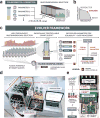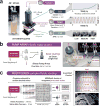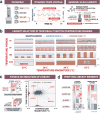Precise, automated control of conditions for high-throughput growth of yeast and bacteria with eVOLVER
- PMID: 29889214
- PMCID: PMC6035058
- DOI: 10.1038/nbt.4151
Precise, automated control of conditions for high-throughput growth of yeast and bacteria with eVOLVER
Abstract
Precise control over microbial cell growth conditions could enable detection of minute phenotypic changes, which would improve our understanding of how genotypes are shaped by adaptive selection. Although automated cell-culture systems such as bioreactors offer strict control over liquid culture conditions, they often do not scale to high-throughput or require cumbersome redesign to alter growth conditions. We report the design and validation of eVOLVER, a scalable do-it-yourself (DIY) framework, which can be configured to carry out high-throughput growth experiments in molecular evolution, systems biology, and microbiology. High-throughput evolution of yeast populations grown at different densities reveals that eVOLVER can be applied to characterize adaptive niches. Growth selection on a genome-wide yeast knockout library, using temperatures varied over different timescales, finds strains sensitive to temperature changes or frequency of temperature change. Inspired by large-scale integration of electronics and microfluidics, we also demonstrate millifluidic multiplexing modules that enable multiplexed media routing, cleaning, vial-to-vial transfers and automated yeast mating.
Conflict of interest statement
Authors have declared that no competing interests exist.
Figures





References
Publication types
MeSH terms
Grants and funding
LinkOut - more resources
Full Text Sources
Other Literature Sources
Molecular Biology Databases

